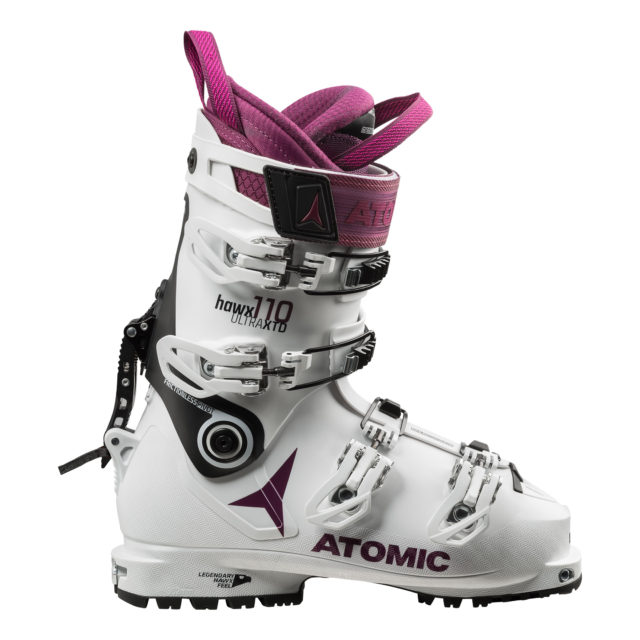
2019-2020 Atomic Hawx Ultra XTD 110 W
Stated Flex Rating: 110
Stated Last Width: 98 mm
Size Tested: 24.5 / 282 mm Boot Sole Length
Stated Range of Motion: 54°
Stated Weight (24.5): 1320 g
Blister’s Measured Weight:
- Shells & Boot Boards, no liners: 992 & 999 grams
- Liners (no spoilers, no footbeds): 244 & 237 grams
- Total Weight per Boot: 1236 & 1236 grams
Liner: Hand-Washable Memory Fit 3D Liner
Shell Material: Grilamid
Sole: Rockered, Rubber, non-replaceable Walk-to-Ride Sole
Binding Compatibility:
- All pin-style / “tech” bindings (e.g., Dynafit, Marker Kingpin, etc.)
- All WTR (Walk-to-Ride) bindings
- Any binding that accepts an ISO 9523 sole (Salomon Warder; Marker Duke / Griffon ID, etc.)
MSRP: $699
Days Tested: 12 (and counting)
Test Locations: San Juan Mountains, CO; Taos Area, NM; Santa Fe, NM; Carrabassett Valley, ME; Cannon Mountain, NH
[Note: Our review was conducted on the 17/18 Hawx Ultra XTD 110 W, which was not changed for 18/19 or 19/20, apart from graphics and a name change to “Hawx Ultra XTD 115 W,” despite no changes being made to the shell.]
Intro
Women’s-specific boots have have been steadily improving over the past decade, but for some women, finding a stiff enough boot for ski touring is still a bit difficult.
In the past, I’ve struggled going back and forth from alpine boots to AT boots, since the AT boots I’ve used have always had a much softer flex. So, considering how much fellow Blister reviewers have been impressed by the men’s Atomic Hawx Ultra XTD, I was eager to see how the women’s version performed.
I’ve now spent a number of days touring in the Hawx Ultra XTD 110 W to compare it to other women’s-specific touring options like the Salomon MTN Explore W, and I’ve also skied it in the resort to see how it compares to full alpine boots.
Atomic describes the boot as follows:
“The line between all-mountain skiing and freeride touring has been blurring for a while now. And now we’ve created the first ever boot to do the same! Meet Atomic Hawx Ultra XTD. What makes it a game-changer is it’s a top performer in both arenas not a compromise: it brings you the legendary feel, skiing power and all-mountain capability of Hawx with the epic natural movement of Backland. This top 110 women’s model is also the lightest, with a women-specific cuff height and shape, and a breathable, washable liner with pre-shaped heel and ankle.”
Fit
To start, my foot is not your foot, and we always recommend working with a trusted local boot fitter to ensure the best fit possible in any boot. That said, I can comment on my own experience with the Hawx Ultra XTD 110 W.
For reference, my feet are average in width with a medium-to-low arch. There is little difference in the width or arch of my foot between sitting and standing, meaning my arch does not collapse much when in a compressed boot or while walking. I do have a slight overpronation and limited mobility in my ankles.
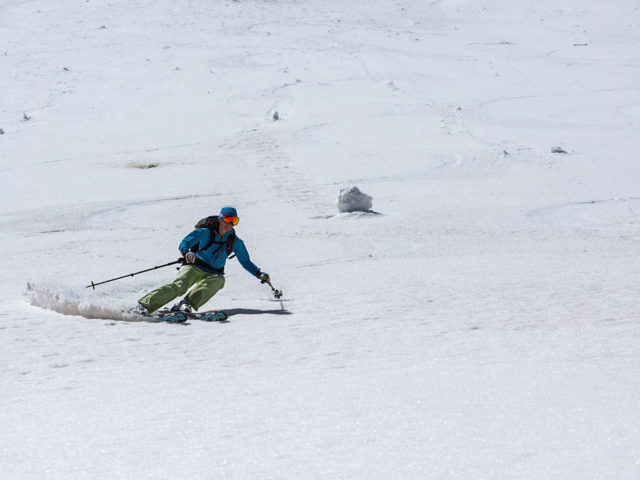
I tend wear a 24.5 in AT boots and a 23.5 in alpine boots, but when I tried on the Atomic Hawx Ultra XTD 110 W for the first time in a 24.5, my foot was swimming inside the boot. Fortunately, Atomic provides plastic inserts that go beneath the liner to raise the foot and take up some of the “vertical” volume inside the boot. The plastic insert decreased the extra volume enough to give me a great fit. (The heel pocket, toe box, and general volume of the Hawx Ultra XTD 110 W are noticeably narrower than the Salomon MTN Explore W boot.)
After adding the plastic inserts, I was happy with the fit of the Hawx Ultra XTD 110 W, and did not have them molded, but see Cy Whitling’s review of the men’s Hawx Ultra XTD 120 for more info on Atomic’s Memory-Fit process.
Buckles and Powerstrap
The Hawx Ultra XTD 110 W has four alpine-style buckles, and the upper buckles have metal slides that allow the buckles to lay flat when the boots aren’t cranked down. Initially, I wasn’t a fan of the buckles as they weren’t as smooth as buckles on my other boots — it took just a little more effort to position them prior to buckling. But by no means is this a deal breaker, and the more I skied in the Hawx Ultra XTD 110 W, the less I noticed the buckles.
The boot’s powerstrap was another part of the boot I noticed right away. The strap sits high up on the boot, and I’ve noticed that it tends to ride up above the liner after a bit of skiing, and ends up pressed against my upper shin. (Jonathan Ellsworth and Cy Whitling didn’t experience this with their Ultra XTD boots.) Thankfully, it is easy to tighten down the boot’s buckles and, unlike other boots I’ve used, it didn’t feel like the powerstrap was needed to maintain the flex.
Walk Mode
The large ski / walk lever of the Hawx Ultra XTD 110 W is easy to use and easy to determine if the boot is fully locked in ski mode (it’s the same walk mode as the men’s version). It does take a little more effort to unlock the boot than it does for other AT boots (e.g. the Salomon MTN Explore W and Black Diamond Diva). I have not had any problems with icing or snow accumulation with the lock mode on the Hawx Ultra XTD 110 W.
Touring
Compared to the Salomon MTN Explore W, the Hawx Ultra XTD feels to me like it has slightly less range of motion. However, the Hawx Ultra XTD 110 W still has enough range of motion to allow for a natural stride, and it was easy to spend hours touring in this boot without issue. The lower volume of this boot and the snug heel pocket has kept my foot from moving around in the boot while touring.
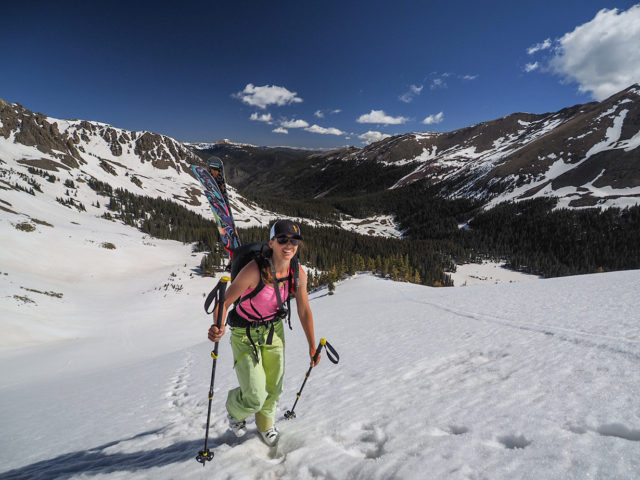
Downhill Performance
The Hawx Ultra XTD has the best downhill performance of all the AT boots I’ve used. And really, these boots aren’t just good for AT boots — I would rank them pretty high in terms of downhill performance against some of the alpine boots I’ve used (e.g., Tecnica Mach1 Pro W LV, Nordica GPX 105 W, and the Head Raptor 110 RS).
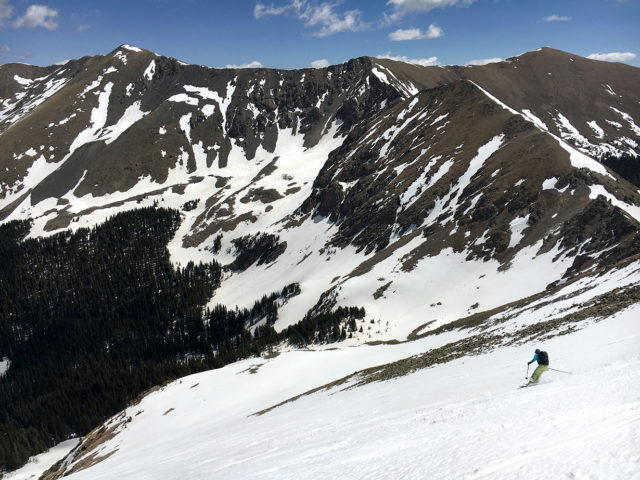
I recently traveled to New England and used the Atomic Hawx Ultra XTD 110 W for some lift-serviced days at Cannon Mountain and Sugarloaf. Over the course of the five days I skied back east, the conditions included powder, chop, firm corduroy, ice, and windblown perfection. Pretty much a full gamut of conditions, and these boots excelled in all of them.
I haven’t had any issues with rearward support, and the Hawx Ultra XTD 110 W’s lateral rigidity feels identical to a good alpine boot. The flex feels pretty progressive, with no real abrupt stop points.
Liner
The big caveat here: so far, Jonathan Ellsworth and I have both only skied in pre-production versions of the Ultra XTD liners, and Atomic went through several more iterations of the liner before the boot went to market for the 17/18 season. We’re hoping to get in the production liners soon, and I will update this review when I do.
The liners that Jonathan and I skied are thin and extremely flexible — things that I don’t usually look for in a boot liner, though these are definitely light liners, and Atomic was certainly looking to keep the weight down. I personally would be happier with a slightly thicker and more rigid liner — even if I had to sacrifice some mobility or deal with more weight while touring. But there are definitely other people that wouldn’t want to sacrifice mobility or deal with more weight (check out our conversation with Atomic boot designer, Matt Manser, on this topic).
So in the prototype liner I’ve been using, there is minimal padding, and the boot felt a little uncomfortable around the upper shin during my first long day on snow in the boots. Thankfully, the thinness of the liner did not seem to compromise the boot’s overall warmth, and I didn’t find these boots to be colder than others.
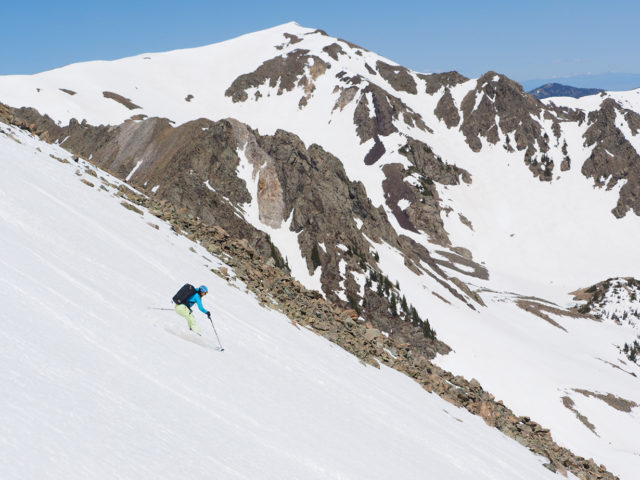
Fortunately, the production liner of the Hawx Ultra XTD 110 W is supposed to be more substantial, but we can’t say yet how similar or different it is. I recommend checking out Cy’s review of the Hawx Ultra XTD 120 for more discussion of liner options, as he brings up some interesting notes after his experience with that boot.
When attempting to slide my foot into the Hawx Ultra XTD 110 W with the thin prototype liner, the liner often collapses, making the process of putting the boots on a bit frustrating. While I have tried several different techniques, I still haven’t found an easy way to get into the boot. So we’re hoping to find that, with the production liner, this will be less of an issue, and the new liner shouldn’t collapse as easily.
But with all this said, once I actually start skiing or skinning in these boots, the liner is not much of an issue, and I didn’t feel like it compromises the uphill or downhill performance of the boot.
Durability
I’ve only spent 12 days in the boots, but so far I have not noticed any softening or scuffing of the shell. The exterior of the boot has held up better than the Salomon Mountain Explore W after a similar amount of use.
Bottom Line
Overall, I’ve been very impressed by both the touring and downhill performance of the Atomic Hawx Ultra XTD 110 W. Though they have a few quirks, I would happily ski in them any day. From the first turn, I was so impressed by these boots that I forgot I was skiing in an AT boot altogether.
I’d recommend the Hawx Ultra XTD 110 W to anyone looking for a stiff yet lightweight backcountry boot, or for those searching for the elusive one-boot quiver for both touring and resort skiing.

nice review! As for getting the boots on without having the liner collapse, i have found that the easiest way of getting in the boots (130xtds) is to put on the liner first, then put on the shell. Zero collapsing liner issues that way :)